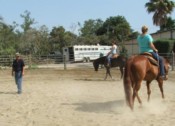





Girth a horse tightly so the
saddle doesn't slip. Wrong! Position the saddle correctly so the saddle doesn't slip. Right! Girth the horse "snugly", but never tightly. Tight girths are just one of the "don't dos" of tacking up. Horses that are girthed tightly soon become "cinchy" and dislike being saddled. Once they resent being saddled, they'll often reach around and try to bite the saddler.or they'll expand their girth area so the girth will be "snug," but comfortable when they relax. That "snug" girth is nearly always "just about right." After all, riding is easy..just keep a leg on each side.and you don't need a tight girth to do that. But before you girth the horse, place the saddle correctly. Ideally the saddle should be placed so it rests solidly and level on the horse's back. In this position, the rider's center of balance will be just behind the horse's natural balance point at a standstill. As the horse begins to move, engaging the hindquarters, his natural balance point (just behind and slightly above his elbow) will move back and under the rider as the horse begins to round his back upward. Now the horse, saddle and rider are in balance. Place the saddle pad or blanket over the withers and well forward. Now place the saddle in position, over the withers and forward. Slide the saddle and pad backward until they settle into position, behind the withers and level on the back. For many, this saddle position is going to seem too far back. It is not. The gullet of the saddle will be somewhat over the withers, the saddle will be level (gullet and cantle level) and the back of the saddle will not be pressing into the loin area. The girth will not be immediately behind the elbow, but will be several inches behind the elbow. If the saddle is left too far forward, well over the withers, and the girth is directly behind the elbow, the movement of the horse's shoulders will be restricted. Both stride and lateral action are adversely affected. Properly position, the saddle will not need to be "tightly" girthed. It stays in position naturally and only needs a "snug" girth to remain there. Now in position, the rider should check the pad or saddle blanket and lift it up into the gullet so that at least two fingers slide easily between the withers and the saddle. Problems arise when the saddle is left propped forward on the horse's withers, or when the saddle is pushed too far back and rests on the loin. (Western saddles with large skirts-mucho room for silver---are usually the saddles that create soreness in the loin area.) Horses with wide flat (mutton) withers can suffer discomfort and pain if the saddle creeps forward toward the neck. Rubberized or "non-slip" grip pads can help avoid this problem. When a saddle is built with a downward slope fore to aft, the rider is seated behind the horse's center of balance, causing unwanted pressure on the horse's back near the loin. You can spot problems from the ground if you just stand back and observe the tacked horse. Are the forks of a western saddle or the pommel of an English saddle sitting higher than the cantle? Is the saddle too far forward crowding the shoulders? Do the bars of the saddle rest on the loins? Do the stirrups hang off the vertical? If the answer to any of those questions is "yes," evaluate the design of the saddle; reposition the saddle and then decide if it is the saddle or just the way the horse was tacked. If, during your review of the saddle positioning, you notice your horse is smiling and appears "ready to go," he is..so snug that girth and enjoy the ride. |